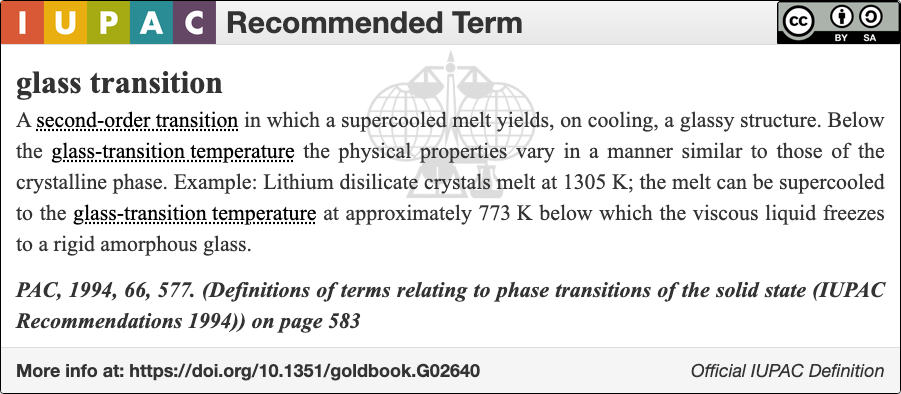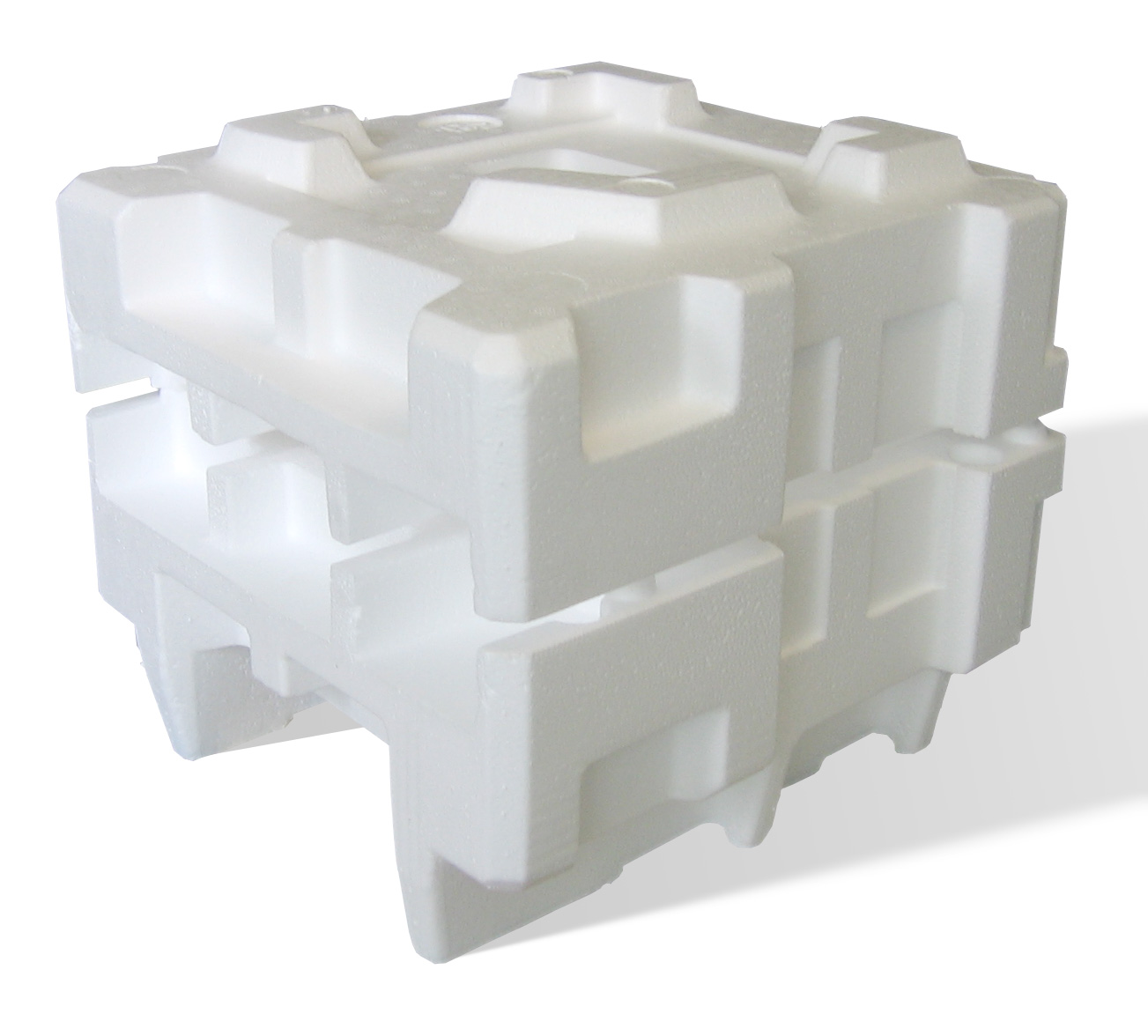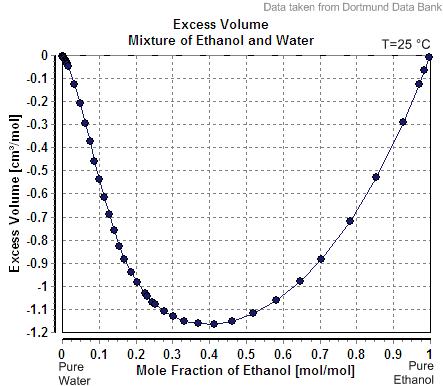|
Flory–Fox Equation
In polymer chemistry and polymer physics, the Flory–Fox equation is a simple empirical formula that relates molecular weight to the glass transition temperature of a polymer system. The equation was first proposed in 1950 by Paul Flory, Paul J. Flory and Thomas G. Fox while at Cornell University. Their work on the subject overturned the previously held theory that the glass transition temperature was the temperature at which viscosity reached a maximum. Instead, they demonstrated that the glass transition temperature is the temperature at which the free space available for molecular motions achieved a minimum value. While its accuracy is usually limited to samples of narrow range molecular weight distributions, it serves as a good starting point for more complex structure-property relationships. Recent molecular simulations have demonstrated that while the functional form of the Flory-Fox relation holds for a wide range of molecular architectures (linear chain, bottlebrush, sta ... [...More Info...] [...Related Items...] OR: [Wikipedia] [Google] [Baidu] |
Polymer Chemistry
Polymer chemistry is a sub-discipline of chemistry that focuses on the structures, chemical synthesis, and chemical and physical properties of polymers and macromolecules. The principles and methods used within polymer chemistry are also applicable through a wide range of other chemistry sub-disciplines like organic chemistry, analytical chemistry, and physical chemistry. Many materials have polymeric structures, from fully inorganic metals and ceramics to DNA and other biological molecules. However, polymer chemistry is typically related to synthetic and organic compositions. Synthetic polymers are ubiquitous in commercial materials and products in everyday use, such as plastics, and rubbers, and are major components of composite materials. Polymer chemistry can also be included in the broader fields of polymer science or even nanotechnology, both of which can be described as encompassing polymer physics and polymer engineering.Hans-Heinrich Moretto, Manfred Schulz ... [...More Info...] [...Related Items...] OR: [Wikipedia] [Google] [Baidu] |
Glass Transition
The glass–liquid transition, or glass transition, is the gradual and Reversible reaction, reversible transition in amorphous solid, amorphous materials (or in amorphous regions within Crystallinity, semicrystalline materials) from a hard and relatively brittle "glassy" state into a viscous or rubbery state as the temperature is increased. International Organization for Standardization, ISO 11357-2: Plastics – Differential scanning calorimetry – Part 2: Determination of glass transition temperature (1999). An amorphous solid that exhibits a glass transition is called a glass. The reverse transition, achieved by supercooling a viscous liquid into the glass state, is called vitrification. The glass-transition temperature ''T''g of a material characterizes the range of temperatures over which this glass transition occurs (as an experimental definition, typically marked as 100 s of relaxation time). It is always lower than the melting point, melting temperature, ''T''m, of the cr ... [...More Info...] [...Related Items...] OR: [Wikipedia] [Google] [Baidu] |
Plasticizer
A plasticizer ( UK: plasticiser) is a substance that is added to a material to make it softer and more flexible, to increase its plasticity, to decrease its viscosity, and/or to decrease friction during its handling in manufacture. Plasticizers are commonly added to polymers and plastics such as PVC, either to facilitate the handling of the raw material during fabrication, or to meet the demands of the end product's application. Plasticizers are especially key to the usability of polyvinyl chloride (PVC), the third most widely used plastic. In the absence of plasticizers, PVC is hard and brittle; with plasticizers, it is suitable for products such as vinyl siding, roofing, vinyl flooring, rain gutters, plumbing, and electric wire insulation/coating. Plasticizers are also often added to concrete formulations to make them more workable and fluid for pouring, thus allowing the water contents to be reduced. Similarly, they are often added to clays, stucco, solid rocket fuel, ... [...More Info...] [...Related Items...] OR: [Wikipedia] [Google] [Baidu] |
Diluent
A diluent (also referred to as a filler, dilutant or thinner) is a diluting agent. Certain fluids are too viscous to be pumped easily or too dense to flow from one particular point to the other. This can be troublesome, because it might not be economically feasible to transport such fluids in this state. To ease this restricted movement, diluents are added. This decreases the viscosity of the fluids, thereby also decreasing the pumping/transportation costs. One industrial application is the transport of crude oil via pipelines. Heavy crude oil/bitumen are fluids with high viscosity, especially at low temperatures. The addition of a diluent enables the diluted fluid ( dilbit in the case of bitumen) to meet pipeline specifications in order for it to be efficiently transported. Typical diluent in this case is naphtha or condensate. Types of diluents more familiar to the general public include paint thinner and nail polish thinner, both of which improve the consistency and app ... [...More Info...] [...Related Items...] OR: [Wikipedia] [Google] [Baidu] |
Polyisobutylene
Polyisobutene (polyisobutylene) is a class of organic polymers prepared by polymerization of isobutene. The polymers often have the formula Me3C H2CMe2sub>nH (Me = CH3). They are typically colorless gummy solids. Cationic polymerization, initiated with a strong Brønsted or Lewis acid, is the typical method for its production. The molecular weight (MW) of the resulting polymer determines the applications. Low MW polyisobutene, a mixture of oligomers with Mns of about 500, is used as plasticizers. Medium and high MW polyisobutenes, with Mn ≥ 20,000, are components of commercial adhesives.{{cite encyclopedia , author1=Kenneth S. Whiteley , author2=T. Geoffrey Heggs , author3=Hartmut Koch , author4=Ralph L. Mawer , author5=Wolfgang Immel , title=Polyolefins , encyclopedia=Ullmann's Encyclopedia of Industrial Chemistry , year=2005 , publisher=Wiley-VCH , place=Weinheim , doi=10.1002/14356007.a21_487 See also *Butyl rubber *Polybutene Polybutene is an organic polymer made from a ... [...More Info...] [...Related Items...] OR: [Wikipedia] [Google] [Baidu] |
Polymethylmethacrylate
Poly(methyl methacrylate) (PMMA) is a synthetic polymer derived from methyl methacrylate. It is a transparent thermoplastic, used as an engineering plastic. PMMA is also known as acrylic, acrylic glass, as well as by the trade names and brands Crylux, Walcast, Hesalite, Plexiglas, Acrylite, Lucite, PerClax, and Perspex, among several others ( see below). This plastic is often used in sheet form as a lightweight or shatter-resistant alternative to glass. It can also be used as a casting resin, in inks and coatings, and for many other purposes. It is often technically classified as a type of glass, in that it is a non-crystalline vitreous substance—hence its occasional historic designation as ''acrylic glass''. History The first acrylic acid was created in 1843. Methacrylic acid, derived from acrylic acid, was formulated in 1865. The reaction between methacrylic acid and methanol results in the ester methyl methacrylate. It was developed in 1928 in several different lab ... [...More Info...] [...Related Items...] OR: [Wikipedia] [Google] [Baidu] |
Polystyrene
Polystyrene (PS) is a synthetic polymer made from monomers of the aromatic hydrocarbon styrene. Polystyrene can be solid or foamed. General-purpose polystyrene is clear, hard, and brittle. It is an inexpensive resin per unit weight. It is a poor barrier to air and water vapor and has a relatively low melting point. Polystyrene is one of the most widely used plastics, with the scale of its production being several million tonnes per year. Polystyrene is naturally transparent to visible light, but can be colored with colorants. Uses include protective packaging (such as packing peanuts and optical disc jewel cases), containers, lids, bottles, trays, tumblers, disposable cutlery, in the making of models, and as an alternative material for phonograph records. As a thermoplastic polymer, polystyrene is in a solid (glassy) state at room temperature but flows if heated above about 100 °C, its glass transition temperature. It becomes rigid again when cooled. This te ... [...More Info...] [...Related Items...] OR: [Wikipedia] [Google] [Baidu] |
Thermal Expansion
Thermal expansion is the tendency of matter to increase in length, area, or volume, changing its size and density, in response to an increase in temperature (usually excluding phase transitions). Substances usually contract with decreasing temperature (thermal contraction), with rare exceptions within limited temperature ranges ('' negative thermal expansion''). Temperature is a monotonic function of the average molecular kinetic energy of a substance. As energy in particles increases, they start moving faster and faster, weakening the intermolecular forces between them and therefore expanding the substance. When a substance is heated, molecules begin to vibrate and move more, usually creating more distance between themselves. The relative expansion (also called strain) divided by the change in temperature is called the material's coefficient of linear thermal expansion and generally varies with temperature. Prediction If an equation of state is available, it can be used t ... [...More Info...] [...Related Items...] OR: [Wikipedia] [Google] [Baidu] |
Jamming (physics)
Jamming is the physical process by which the viscosity of some Mesoscopic physics, mesoscopic materials, such as granular materials, glasses, foams, polymers, emulsions, and other complex fluids, increases with increasing particle density. The jamming transition has been proposed as a new type of phase transition, with similarities to a glass transition but very different from the formation of crystalline solids. While a glass transition occurs when the liquid state is cooled, the jamming transition happens when the density, or the packing fraction of the particles, is increased. This crowding of the constituent particles prevents them from flowing under an applied stress and from exploring phase space, thus making the aggregate material behave as a solid. The system may be able to unjam if Packing density, volume fraction is decreased, or external stresses are applied such that they exceed the yield stress. This transition is interesting because it is Nonlinear system, nonlinea ... [...More Info...] [...Related Items...] OR: [Wikipedia] [Google] [Baidu] |
Volume Fraction
In chemistry and fluid mechanics, the volume fraction \varphi_i is defined as the volume of a constituent ''V''''i'' divided by the volume of all constituents of the mixture ''V'' prior to mixing: :\varphi_i = \frac . Being dimensionless quantity, dimensionless, its unit is 1; it is expressed as a number, e.g., 0.18. It is the same concept as volume percent (vol%) except that the latter is expressed with a denominator of 100, e.g., 18%. The volume fraction coincides with the ''volume concentration'' in ideal solutions where the volumes of the constituents are additive (the volume of the solution is equal to the sum of the volumes of its ingredients). The sum of all volume fractions of a mixture is equal to 1: :\sum_^ V_i = V ; \qquad \sum_^ \varphi_i = 1. The volume fraction (percentage by volume, vol%) is one way of expressing the composition of a mixture with a dimensionless quantity; mass fraction (chemistry), mass fraction (percentage by weight, wt%) and mole fraction (per ... [...More Info...] [...Related Items...] OR: [Wikipedia] [Google] [Baidu] |
Rubber Elasticity
Rubber elasticity is the ability of solid rubber to be stretched up to a factor of 10 from its original length, and return to close to its original length upon release. This process can be repeated many times with no apparent Material failure theory, degradation to the rubber. Rubber, like all materials, consists of Molecule, molecules. Rubber's Elasticity (physics), elasticity is produced by Molecular dynamics, molecular processes that occur due to its molecular structure. Rubber's molecules are Polymer, polymers, or large, chain-like molecules. Polymers are produced by a process called polymerization. This process builds polymers up by sequentially adding short molecular backbone units to the chain through Chemical reaction, chemical reactions. A rubber polymer follows a random winding path in three dimensions, intermingling with many other rubber polymers. Natural rubbers, such as polybutadiene and polyisoprene, are extracted from plants as a fluid colloid and then solidified ... [...More Info...] [...Related Items...] OR: [Wikipedia] [Google] [Baidu] |








